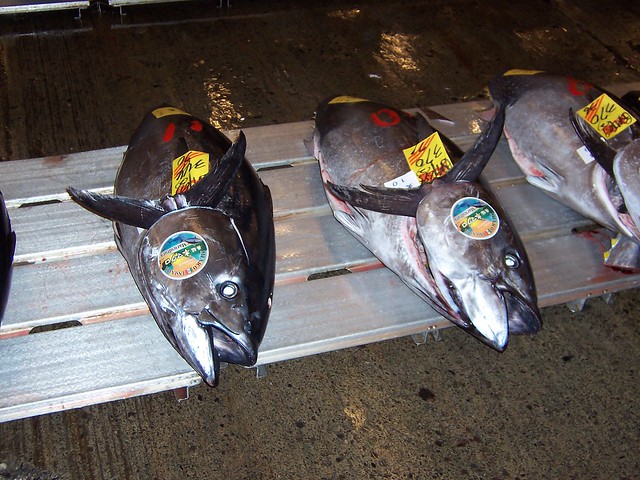In October 2012, the International Commission for the Conservation of Atlantic Tunas (ICCAT), the organization charged with managing Atlantic bluefin tuna, finalised new stock assessments showing an increase in both the eastern and western populations. Recognising the high degree of uncertainty in the models, ICCAT’s scientific committee (SCRS) recommended that quotas remain the same, to allow bluefin populations to continue to grow. While this is good news, the story is far from over and bluefin managers must carefully nurture this fragile recovery and not undermine improvements before they can take hold.
In November 2012, ICCAT member governments must now apply these recommendations from the ICCAT scientific committee to their decision- making. Governments must look to the future: before considering increasing quotas they should ensure that the scientific models used to determine the status of the population and for setting appropriate fishing levels are sound and that illegal fishing is accounted for and addressed.
Key discussions among ICCAT members are taking place right now in conjunction with the new stock assessments. Decisions are being made behind closed doors that will determine these quotas. ICCAT members must now apply the recommendations from ICCAT’s own scientific committee to their decision making.
Illegal Catch Continues
The 2012 study estimates that total allowable quotas were exceeded by 62 percent between 2005 and 2011 and by 77 percent between 2008 and 2011, confirming previous reports of persistent and widespread illegal fishing in the BFTE. This means that catch exceeded the quota by approximately 112,000 metric tons (mt) during the seven-year study period. Further, the gap between actual catch and the quotas is likely to be even higher due to black market trade and several other factors not captured in official records.
The study authors gathered monthly import and export records from several official trade sources for 38 countries, representing 97.5 percent of the total imports and exports of BFTE. They combined data on a quarterly basis and cross- checked sources and import and export records. In cases where the import and export records differed, the authors presented a number of options for selecting data and highlighted the scenario believed to best reflect reality. To enable a comparison with total allowable quotas (mt) for each year, the authors also performed a series
of calculations to translate the weight of traded bluefin tuna products (filets, loins, etc.) into the weight of the whole fish at the time of catch.
Why Does This Matter Now?
In September 2012, the SCRS, ICCAT’s scientific body, conducted a stock assessment to determine the health of the eastern and western Atlantic bluefin populations. In October, the SCRS reconvened to finalise its management advice based on the results of the stock assessments. In November 2012, ICCAT managers will meet in Agadir, Morocco to set both eastern and western Atlantic bluefin quotas for the next two to three years. The SCRS’s ability to accurately count the number of Atlantic bluefin in the east and west is crucial to the sound management and future of bluefin.
While the 2012 assessment ignored recent illegal catch estimates, in its report to ICCAT the SCRS recognised the benefits of these trade studies and recommended that ICCAT set up a working group to further examine trade data relative to reported catch data so as to get a better handle on illegal catch. More importantly, given the significant uncertainty surrounding the stock assessment, the SCRS recommended that managers keep the BFTE quota at or near the current quota of 12,900 mt.
Crucial Next Steps
The Pew Environment Group is calling on ICCAT to heed the scientific advice and not increase quotas until illegal fishing is addressed and the best available science is incorporated into the stock assessment.
Additionally, the Pew Environment Group is asking ICCAT to:
- Swiftly adopt an electronic version of the current paper-based catch documentation system to allow for the effective and real-time tracking of bluefin catches and to reduce the opportunities for illegal trade;
- Develop a formal working group of experts that will use trade data and official catch documents to provide an estimate of illegal catch to be included in the next stock assessment;
- Investigate sources of illegal catch to determine whether it results from under- reporting by ‘legal’ vessels operating within the quota system or from unreported landings by vessels not authorised to catch bluefin tuna.
Further resources:
- The Story of Atlantic Bluefin Tuna (PDF)
- Illegal Bluefin: Challenges to Accurately Counting Bluefin in the Eastern Atlantic and Mediterranean (PDF)
- Improving the Count of Western Atlantic Bluefin Tuna: A Review of New Science in 2012 (PDF)
Contact: Amanda Nickson | Director of Global Tuna Conservation Pew Environment Group | anickson@pewtrusts.org | Tel. +1 (202)540-6528. Visit us at www.PewEnvironment.org/Tuna
Photo courtesy of travels of a monkey via Flickr (CC BY 2.0)

